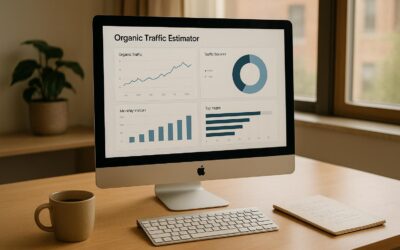- Awareness (Informational Intent): Users identify problems and seek answers. Focus on creating educational content like guides or tutorials.
- Consideration (Commercial Intent): Users compare solutions and evaluate options. Provide comparison guides, case studies, and feature analysis.
- Decision (Transactional Intent): Users are ready to act. Offer clear pricing, social proof, and strong calls-to-action.
Quick Overview of Search Intent Types:
| Intent | Example Query | Goal |
|---|---|---|
| Informational Intent | "How to fix a leaky faucet" | Learn or solve a problem |
| Commercial Intent | "Best SEO tools 2025" | Compare and evaluate options |
| Transactional Intent | "Buy SEO services near me" | Make a purchase or take action |
Start by identifying intent-based keywords for each stage, create tailored content, and measure performance to refine your strategy. This approach ensures your content meets user needs at every stage of their journey.
Map Your Keywords to the Buyer’s Journey and User Intent …
Awareness Stage Search Intent
During the awareness stage, users are starting to recognize and define their problems. Their search behavior reflects this phase of discovery, focusing on gathering information and answering basic questions.
How Users Search in the Awareness Stage
In this stage, users often use broad and problem-specific search queries. These searches typically include:
- Questions like "why is my website loading slowly"
- Problem statements such as "fix website ranking drops"
- Descriptions of symptoms like "website not appearing in Google"
The goal of these searches is purely to gather information.
| Search Type | Common Patterns | Objective |
|---|---|---|
| Question-Based | How, Why, What, When | Understanding the basics |
| Problem-Focused | Fix, Solve, Help with | Looking for solutions |
| Educational | Guide, Tutorial, Learn | Gaining knowledge |
| Diagnostic | Symptoms, Signs, Causes | Identifying the problem |
Understanding these query types is essential for creating content that meets the needs of users in this phase.
Creating Content for Information Searches
To meet the needs of awareness-stage users, develop content that directly addresses their informational needs. Your content should:
- Answer common industry questions clearly and thoroughly
- Simplify complex topics into easy-to-follow explanations
- Include practical examples to clarify key points
- Avoid pushing sales or promotional messages
At this stage, users are not ready to compare products or make purchasing decisions. Instead, they’re looking for educational resources to better understand their issues and explore possible solutions. For instance, if someone searches "how to improve website visibility", your content should explain the basics of SEO, outline common visibility challenges, and provide actionable tips.
Consideration Stage Search Intent
In this stage, users move from gathering information to evaluating specific solutions. Their searches become more focused and actionable, signaling they’re comparing options and looking for the best fit.
What Is Commercial Intent?
Commercial intent refers to searches where users are actively comparing potential solutions before making a purchase. These searches often include:
- Solution comparison queries like "best SEO tools 2025"
- Feature analysis searches such as "enterprise SEO platform features"
- Value assessment terms like "SEO software pricing plans"
Common modifiers in these searches include:
| Modifier | Example Query | User’s Goal |
|---|---|---|
| Best | "best website optimization tools" | Identify top options |
| vs/versus | "Shopify vs custom ecommerce SEO" | Compare alternatives |
| Reviews | "enterprise SEO platform reviews" | Read user feedback |
| Pricing | "website optimization service costs" | Assess cost |
| Features | "advanced SEO tracking capabilities" | Understand functionality |
Content Types for Product Research
To address these queries effectively, create content that helps users make informed decisions:
Comparison Guides
Develop detailed guides that compare different solutions or approaches. For instance, when covering website optimization strategies, explain how various methods work for businesses of different sizes and industries.
Case Studies
Showcase real-world examples with metrics, timelines, and methods. Highlight how your solution addressed similar challenges and delivered measurable results.
Feature Analysis Content
Break down the capabilities of your solution in detail. Include information such as:
- Technical specs and system requirements
- Complexity of implementation
- Resources needed
- Expected results and timelines
- Potential return on investment
Focus on providing clear, actionable insights that help users evaluate their options and make confident decisions.
sbb-itb-880d5b6
Decision Stage Search Intent
At the decision stage, users are ready to take action – they’re prepared to buy or commit.
Signs of Purchase Intent
Searches at this stage often include transactional keywords and modifiers, signaling a strong intent to make a purchase. Here’s how these searches typically look:
| Intent Signal | Example Queries | User Goal |
|---|---|---|
| Purchase Terms | "buy SEO services", "get started with SEO" | Ready to make a purchase |
| Location-Specific | "SEO agency near me", "local SEO consultant" | Searching for a nearby provider |
| Price-Related | "SEO service packages", "SEO consultation cost" | Finalizing pricing details |
| Contact Intent | "schedule SEO consultation", "book SEO audit" | Looking to connect with a provider |
| Implementation | "start SEO optimization", "begin website audit" | Ready to begin the solution |
These searches often lead to higher conversions because users have already:
- Finished their research
- Defined their needs
- Set a budget
- Decided on the type of solution they want
These behaviors should guide how you approach sales-focused content.
Sales-Focused Content Creation
Use these purchase signals to craft content that encourages action and removes any remaining barriers. To convert decision-stage visitors, your content should focus on clarity and urgency. Here’s what to include:
Pricing and Package Information
Be upfront about pricing. Clearly outline your service tiers, features, and deliverables. Transparency helps users feel confident in their decision.
Social Proof
Reassure potential customers by including validation elements, such as:
- Results from past campaigns
- Certifications and awards
- Client success stories with measurable outcomes
- Team credentials and expertise
Effective Call-to-Actions (CTAs)
Strategically place CTAs to guide users toward conversion:
1. Primary CTAs
Position these prominently, like at the top of the page, with action-driven text such as "Start Your SEO Audit" or "Schedule Your Consultation."
2. Supporting CTAs
Scatter secondary options throughout the content, such as:
- "Download Pricing Guide"
- "View Service Packages"
- "Book Discovery Call"
3. Exit-Intent CTAs
Catch users before they leave with offers like:
- Limited-time discounts
- Free consultations
- Quick-start guides
Technical Optimization Tips
- Improve page loading speed
- Ensure the site works well on mobile devices
- Simplify forms to reduce friction
- Highlight trust signals (e.g., security badges, testimonials)
- Make the next steps clear and easy to follow
This approach ensures your content aligns with the intent of decision-stage users, driving them toward conversion.
How to Map Search Intent Step by Step
To align keyword intent with your content strategy, follow these steps. This approach connects search intent insights to actionable strategies tailored to the buyer’s journey.
Finding Intent-Based Keywords
Pinpoint keywords that align with each stage of the buyer’s journey:
| Journey Stage | Intent Signals | Content Focus |
|---|---|---|
| Awareness | What, How, Why | Educational |
| Consideration | Compare, Best, Top | Evaluative |
| Decision | Buy, Price, Cost | Transactional |
When analyzing keywords, focus on:
- Search volume: Look for terms with consistent monthly searches.
- Competition level: Choose keywords that balance difficulty with potential ROI.
- Intent clarity: Prioritize terms that clearly reflect user goals.
- Business relevance: Ensure keywords align with your products or services.
Content Planning by Journey Stage
Craft content that matches the intent of each stage:
- Awareness Stage Content: Provide in-depth resources that answer common questions.
- Consideration Stage Content: Offer tools and comparisons to help users evaluate options.
- Decision Stage Content: Focus on materials that simplify purchase decisions.
Each type of content should guide users smoothly to the next stage of their journey.
Measuring and Improving Results
Use these metrics to evaluate how well your strategy aligns with search intent:
| Metric | What to Measure | Goal |
|---|---|---|
| Time on Page | How long users stay engaged | 3+ minutes |
| Bounce Rate | Percentage of single-page exits | Under 40% |
| Conversion Rate | Actions tied to each stage | 2-5% improvement |
| Page Value | Revenue contribution per page | Positive growth |
To refine your strategy:
- Track user behavior: Analyze how visitors interact with your content.
- Adjust content mix: Focus more on formats that perform well.
- Refresh keywords: Update your targeting based on performance data.
- Improve navigation: Make it easier for users to move between journey stages.
Your goal is to create a seamless experience that guides users from awareness to decision, with content that consistently aligns with their search intent.
Conclusion: Why Intent Mapping Matters
Aligning search intent with buyer journey stages creates a smooth path from awareness to purchase, drawing in the right audience and improving key performance metrics. By using the strategies discussed earlier, intent mapping connects each stage of the buyer journey and delivers measurable business results.
Here’s what intent mapping brings to the table:
Better User Experience
- Content tailored to user needs at every stage
- Lower bounce rates
- Higher engagement with your site
Higher Conversion Rates
- Traffic from keywords that match user intent
- Content aligned with what users are looking for
- A simplified path to purchase
Clear Business Results
- Increased page value and revenue
- More qualified leads
- Improved ROI from your content efforts
The results speak for themselves. Jake Hecker shared his experience:
"Would never do business with anyone else in the SEO space other than with SearchX! The professionalism and quality of work behind this team is unmatched in the industry. They helped drive more business to my team than I could have ever dreamed of."




